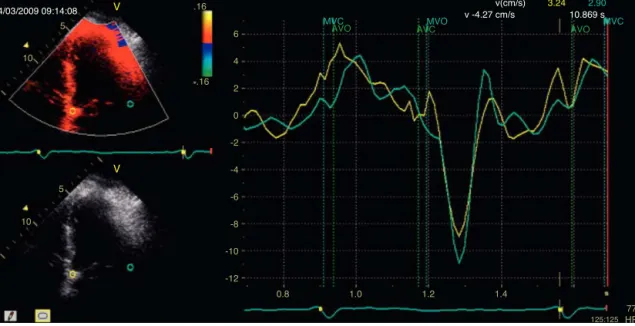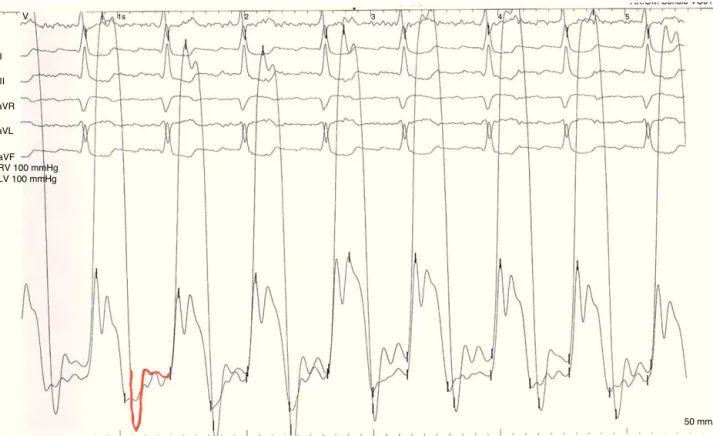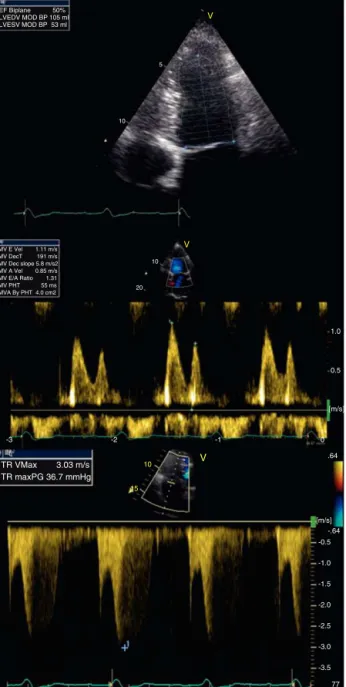Revista Portuguesa de
Cardiologia
Portuguese Journal of Cardiology
www.revportcardiol.org
CASE REPORT
Constrictive pericarditis --- New methods in the diagnosis of an old
disease: A case report
夽
Doroteia Silva
a,∗, Luís Sargento
a, Manuel Gato Varela
a, M.G. Lopes
b, Dulce Brito
a,b,
Hugo Madeira
baServic¸o de Cardiologia I, Hospital de Santa Maria, Centro Hospitalar Lisboa Norte, Lisboa, Portugal bClínica Universitária de Cardiologia, Faculdade de Medicina de Lisboa, Lisboa, Portugal
Received 18 April 2011; accepted 25 January 2012 Available online 16 September 2012
KEYWORDS Constrictive pericarditis; Diagnosis; Imaging
Abstract Constrictive pericarditis is a rare clinical entity that can pose diagnostic problems. The gold standard for diagnosis is cardiac catheterization with analysis of intracavitary pres-sure curves, which are high and, in end-diastole, equal in all chambers. The diastolic profile in both ventricles presents the classic dip-and-plateau pattern and the difference between the diastolic pressures of both ventricles should not exceed 3---5 mmHg. Unfortunately, these tradi-tional criteria are not always present and in fact the sensitivity and specificity of equalization of diastolic pressures are relatively low and of limited value in individual patients. This highlights the need to use new cardiac imaging techniques to resolve any doubts. The case described here is a good example.
© 2011 Sociedade Portuguesa de Cardiologia. Published by Elsevier España, S.L. All rights reserved. PALAVRAS-CHAVE Pericardite constritiva; Diagnóstico; Imagem
Pericardite constritiva --- novos métodos no diagnóstico de uma velha doenc¸a: a propósito de um caso clínico
Resumo A pericardite constritiva é uma entidade clínica rara que pode colocar problemas diagnósticos. O método padrão para a confirmac¸ão do seu diagnóstico é o cateterismo cardíaco, com análise das curvas de pressão intracavitárias, as quais estão elevadas e, em telediástole, são iguais em todas as cavidades. O seu perfil diastólico em ambos os ventrículos apresenta o clássico aspeto dip-plateau e a diferenc¸a entre as pressões telediastólicas ventriculares não deve exceder 3-5 mmHg. Infelizmente estes critérios clássicos nem sempre se verificam e, na verdade, a sensibilidade e a especificidade da igualizac¸ão das pressões telediastólicas dos
夽 Please cite this article as: Silvia D, et al. Pericardite constritiva --- novos métodos no diagnóstico de uma velha doenc¸a: a propósito de
um caso clínico. Rev Port Cardiol. 2012.doi:10.1016/j.repc.2012.07.004.
∗Corresponding author.
E-mail address:dojreis@hotmail.com(D. Silva).
678 D. Silva et al.
ventrículos é relativamente baixa e de valor limitado no doente individualmente considerado. Esta realidade evidencia a necessidade de utilizar as novas técnicas de imagem cardíaca, que podem tornar claro o que é duvidoso. O caso clínico aqui descrito é um bom exemplo. © 2011 Sociedade Portuguesa de Cardiologia. Publicado por Elsevier España, S.L. Todos os direitos reservados.
Case report
A 78-year-old white man was admitted for severe decom-pensated heart failure (NYHA class IV), predominantly right-sided, which had progressively worsened over the pre-vious three months. He had a history of hypertension, type 2 diabetes and dyslipidemia and was a former smoker. He had been admitted to a different hospital eleven years previously with a large pericardial effusion, for which he underwent pericardiocentesis and 3000 ml of pericardial fluid compatible with exudate was drained, but the etiology was not determined, cytological, microbiological and bacte-riological tests being negative. Chest computed tomography (CT) showed pleural and pericardial thickening, which was not investigated. The patient reported no history of tuber-culosis and had a negative tuberculin test. He had remained asymptomatic until three months before the current hos-pitalization, when progressive and disabling global heart failure began.
On physical examination at admission to the cardiology department, the patient was hemodynamically stable (blood pressure 120/70 mmHg), tachypneic (24 cpm), not cyanotic (94% oxygen saturation in room air) but pale. His pulse was strong, irregular and symmetrical. Cardiac and pulmonary auscultation revealed a low intensity arrhythmia, an early third sound, a holosystolic mitral murmur radiating to the axilla and diminished breath sounds in the both lung bases, accompanied by pulmonary rales. There was marked jugu-lar venous distension up to the mandibujugu-lar angle, painless hepatomegaly (liver palpable 10 cm below the right costal margin on the mid-clavicular line), positive hepatojugular reflux and lower limb edema up to the knee (+++/++++).
The electrocardiogram revealed atrial flutter with vari-able atrioventricular block and normal voltage. Laboratory tests showed marked elevation of erythrocyte sedimenta-tion rate (ESR) (98 mm) with no leukocytosis or neutrophilia, and low C-reactive protein (3 mg/dl). Liver enzymes pre-sented a pattern of passive congestion (alkaline phosphatase and gamma-glutamyl transferase higher than aminotrans-ferase). NT-proBNP was normal (142 pg/ml). The chest X-ray, in posteroanterior view, showed a normal cardiothoracic index and a small bilateral pleural effusion, and in pro-file view, a linear image located at the left ventricular (LV) lateral wall, of whitish appearance. Echocardiography per-formed at admission showed the entire pericardium to be thickened and hyperechogenic, no ventricular dilatation, moderately impaired LV global systolic function (ejection fraction [EF] 38% by Simpson’s biplane method) and biatrial dilatation. There was mild mitral and tricuspid regurgita-tion, and tricuspid valve flow showed respiratory variation
of around 30%. Mitral valve flow did not present significant respiratory variation; E-wave deceleration time was 120 ms (mean of five complexes). Echocardiographic study also doc-umented severe pulmonary hypertension (pulmonary artery systolic pressure [PASP] 70 mmHg) and dilatation of the infe-rior vena cava (28 mm), with reduced respiratory variation (<50%).
The main diagnostic hypothesis was constrictive peri-carditis (CP). Concomitant coronary artery disease was also considered, since the patient had multiple cardiovascu-lar risk factors and presented depressed left ventricucardiovascu-lar systolic function, as was pulmonary disease (in a former smoker with pleural thickening), which would explain the elevated PASP. Combined constrictive/restrictive cardiomy-opathy could not be ruled out.
Complementary diagnostic exams included the latest echocardiographic modalities, notably assessment of LV strain and longitudinal early diastolic mitral annular veloc-ity (E’). LV longitudinal strain was preserved, as was early diastolic mitral annular velocity (septal E’: 8.4 cm/s; E/E’: 8.3) (Figure 1), with a respiratory variation of >25%. How-ever, circumferential strain was reduced, a finding that supported a diagnosis of CP. As in the exam performed 11 years previously, chest CT showed diffuse pericardial thickening, but this time focal pericardial calcification was also observed. There were no significant parenchymal lung lesions (Figure 2). Cardiac magnetic resonance imaging (MRI) confirmed mild pericardial thickening in the basal and mid ventricular walls, reaching 3 mm in the lateral LV wall (nor-mal <2 mm). Ventricular volumes and right ventricular EF were normal (LVEF 40%, moderately impaired), and there was mild mitral regurgitation. No delayed enhancement study was performed, as the patient did not wish to continue the exam.
On the 6th day of hospital stay, hemodynamic assess-ment showed elevated LV end-diastolic pressure (22 mmHg) and pulmonary artery wedge pressure (22 mmHg) despite six days of diuretic therapy, a slightly diminished cardiac index (1.87 l/min/m2), and persistent pulmonary hypertension
(mean pulmonary artery pressure 38 mmHg). Although the LV pressure curve presented a dip-and-plateau pattern, the right ventricular curve did not. Furthermore, end-diastolic pressures in the left chambers showed a difference of >5 mmHg compared to the right chambers (Figure 3), which did not support a diagnosis of CP. Coronary angiography excluded significant lesions and ventriculography showed impaired global systolic function (EF 45%) and generalized LV hypokinesia.
We arrived at a diagnosis of CP in the light of the clinical picture, laboratory tests (normal NT-proBNP) and
MVC MVO MVC AVO 3.24 2.90 v -4.27 cm/s v(cm/s) 10.869 s AVC AVO V V 6 .16 .16 4 2 0 -2 -4 -6 5 10 15 10 04/03/2009 09:14:08 5 15 -8 -10 -12 0.8 1.0 1.2 1.4 77 HR 125:125
Figure 1 Normal early diastolic mitral annular velocity (E’) supporting a diagnosis of constrictive pericarditis.
noninvasive imaging studies (chest X-ray and CT and cardiac MRI). Some Doppler echocardiographic findings supported the diagnosis (restrictive pattern and tricuspid flow with respiratory variation >25%), while others did not (mitral flow without respiratory variation); the new echocardiog-raphic modalities (2D strain and tissue Doppler of the mitral annulus) favored the principal hypothesis, unlike the hemo-dynamic study.
After clinical discussion, a diagnosis of CP prevailed and the patient was accordingly referred for surgical pericardial decortication, which was performed 19 days after admis-sion.
During the procedure, the thickened pericardial mem-brane was completely removed (Figure 4), and pleural and pulmonary biopsy specimens were taken. Anatomopatho-logical study of the specimens showed marked fibrous thickening of the pericardium with focal congestion and non-specific chronic inflammatory infiltrate, and several focal dystrophic calcifications; areas of pleural fibrous thickening
Figure 2 Chest CT showing pericardial thickening and calcifi-cation.
with anthracotic pigment; and areas of emphysema and interstitial fibrosis, congestion and mild nonspecific chronic focal inflammatory infiltrate in pulmonary tissue.
Etiological studies performed during hospitalization (blood cultures, tuberculin testing, serum adenosine deam-inase levels, and viral serology) were negative.
The postoperative period was uneventful and the patient was discharged from our hospital one month after admission, significantly improved, and was in NYHA functional class I after 29 months. The patient’s echocardiogram (Figure 5), in sinus rhythm, showed improved global systolic function (EF 50% by Simpson’s biplane method) and LV circumferential strain. E-wave deceleration time was 191 ms (higher than initially) and the E/A ratio was 1.3, confirming improved diastolic function. There was no significant respiratory varia-tion in valve flows and PASP was 42 mmHg (right atrium/right ventricle gradient: 37 mmHg), significantly lower than on ini-tial assessment, probably due to improved LV systolic and diastolic function. The inferior vena cava presented nor-mal caliber and respiratory variation. A month and a half after this last cardiovascular evaluation, the patient first presented rheumatoid arthritis.
Discussion
Constrictive pericarditis is a rare but serious consequence of chronic inflammation of the pericardium that results in a rigid fibrotic shell that constricts the cardiac chambers. The hemodynamic repercussions of this structural change include severe dysfunction of ventricular diastolic filling, which can be additionally aggravated by systolic dysfunc-tion due to secondary myocardial fibrosis and atrophy.1 In the case presented, the patient had systolic and diastolic dysfunction due to the prolonged evolution of CP. There is usually a long interval between the initial pericardial lesion and the onset of constriction,1 which in our patient was 11 years.
680 D. Silva et al. ! I 0 1s 2 3 4 ! II ! III V ! aVR ! aVL ! aVF RV 100 mmHg LV 100 mmHg 5 50 mm/s
Figure 3 Ventricular pressures with left ventricular dip-and-plateau pattern.
A diagnosis of CP should always be considered in patients presenting with predominantly right heart failure symptoms, such as increased jugular venous pressure, pleural effu-sion, hepatomegaly, ascites and peripheral edema. Besides these systemic features, another characteristic of CP is the presence of an early third sound (pericardial knock), which results from a sudden cessation of ventricular filling due to pericardial constriction.2 In more severe cases, there is hypotension and circulatory collapse.
Conventional and Doppler echocardiography play an important role in diagnosing this entity, and in differen-tial diagnosis with other causes of right ventricular (RV) failure,3 of which restrictive cardiomyopathy (RCM) is the most challenging to differentiate, since it has similar fea-tures on Doppler and hemodynamic study. The presence of LV systolic dysfunction in our patient, which is more com-mon in RCM than in CP, made differential diagnosis essential. Dynamic respiratory variation in flow and enhanced ventri-cular interaction, which are found in CP but not RCM, are the most important pathophysiological processes for differen-tial diagnosis.1In CP, there is a dissociation of intrathoracic and intracardiac pressures, which results in a decrease in LV filling during inspiration. A rigid and noncompliant pericardium leads to enhanced ventricular interaction and hence increased RV filling during inspiration. Doppler and tissue Doppler echocardiography play a crucial role in anal-ysis of these respiratory changes.1When doubts remain, new echocardiographic modalities can help in diagnosis. Since in CP, the mechanical and elastic properties of the myocardium are relatively preserved longitudinally but attenuated cir-cumferentially and, while rotation of the basal and mid segments is preserved, apical rotation is markedly reduced,
it is assumed that longitudinal strain and early diastolic mitral annular velocity (E’) will be normal or increased (unlike in RCM), and that circumferential strain and the net twist angle (difference between apical and basal rotation) will be reduced (as in RCM). The net twist angle was not assessed in our patient.
Mitral E’ of >8 cm/s differentiates CP from RCM with a sensitivity of 89% and specificity of 100%.4 Conven-tional, Doppler and 2D strain echocardiography were crucial for differential diagnosis between CP and RCM in our patient, and were also used to assess changes in cardiac
Figure 4 Intraoperative photograph showing thickened peri-cardial membrane.
EF Biplane LVEDV MOD BP LVESV MOD BP 50% 105 ml 53 ml TR VMax 3.03 m/s TR maxPG 36.7 mmHg -0.5 -.64 [m/s] .64 [m/s] 0.5 1.0 10 10 5 20 -1.0 -1.5 -2.0 -2.5 -3.0 -3.5 77 HR -3 -2 -1 V V V 10 15 0 -3 -2 -1 0 1
Figure 5 Postoperative echocardiography. Top: left ventri-cular ejection fraction (50% by Simpson’s biplane method); middle: mitral flow (in sinus rhythm; deceleration time: 191 ms; E/A ratio: 1.3); bottom: tricuspid flow (right ventricle/right atrium gradient: 37 mmHg).
morphology and function following pericardial decorti-cation. Postoperative improvement in LVEF supports the hypothesis that systolic dysfunction was secondary to chronic inflammation and myocardial fibrosis arising from prolonged pericardial constriction, which is uncommon and thus makes our case somewhat unusual. Delayed enhance-ment cardiac MRI, which was not performed in our case due to the patient’s refusal, would have detected any areas of intramyocardial fibrosis. Nevertheless, normal ini-tial values for longitudinal strain and improved EF after surgery point to the absence of severe intramyocardial fibrosis.
Chest CT and cardiac MRI will detect a thickened peri-cardium in CP, but the information they provide is merely anatomical and does not necessarily reflect pathophysio-logical changes.5 In the case presented, these two exams supported our principal diagnostic hypothesis by document-ing pericardial thickendocument-ing with focal calcification. However, it should be remembered that 18% of patients with surgically proven CP present normal pericardial thickness and so the absence of thickening does not exclude CP.6
Measurement of NT-proBNP can also help in diagnosis, as patients with CP present normal (as in our case) or slightly elevated values, while those with RCM present very high levels.7The fact that our patient recently developed rheumatoid arthritis may explain his elevated ESR, since alterations in laboratory analyses frequently precede symp-toms in this type of disease.
With regard to hemodynamic findings, the patient’s LV systolic and diastolic dysfunction explained his reduced cardiac index and elevated LV end-diastolic, pulmonary wedge, and pulmonary artery pressures, the latter proba-bly exacerbated by concomitant lung disease (emphysema) documented on pulmonary biopsy. Various possibilities were considered to explain the absence of equalization of ventri-cular end-diastolic pressures in our patient, the most likely being volume depletion at the time of cardiac catheteriza-tion after six days of diuretic therapy. A bolus of addicatheteriza-tional fluid should be administered to confirm the presence of con-striction, but this was not done as the patient had an episode of acute pulmonary edema in the context of hyperten-sive crisis the day before the hemodynamic study. Although cardiovascular catheterization, which can identify the typ-ical hemodynamic behavior of CP, is considered the gold standard diagnostic method, in a recent study using high-fidelity, micromanometer-tipped catheters to differentiate between CP and RCM, the predictive power of conven-tional CP criteria was only 75%. The same study found that a new criterion --- the systolic area index (which assesses the change in ventricular pressure area during inspiration and expiration and considers a ratio of more than 1.1 to be indicative of enhanced ventricular interaction) --- had 97% sensitivity and 100% predictive accuracy for identify-ing patients with surgically proven CP.8However, while the use of micromanometers may confer greater accuracy in assessing intracavitary pressures, they do not appear prefer-able to new cardiac imaging modalities, which are easier, quicker, noninvasive and reliable, and should be used in the diagnosis of doubtful cases of constrictive pericarditis.
Conflicts of interest
The authors have no conflicts of interest to declare.
References
1. Maisch B, Seferovic P, Ristic A, et al. Guidelines on the diag-nosis and management of pericardial diseases. The Task Force on the Diagnosis and Management of Pericardial Diseases of the European Society of Cardiology. Eur Heart J. 2004;25:587---610. 2. LeWinter MM. Pericardial diseases. In: Libby P, Bonow RO, Mann
DL, Zipes DP, Braunwald E, editors. Braunwald’s heart disease: a textbook of cardiovascular medicine. 8th ed. Philadelphia: Saun-ders Elsevier; 2008. p. 1843.
682 D. Silva et al. 3. Dal-Bianco J, Sengupta P, Mookadam F, et al. Role of
echocar-diography in the diagnosis of constrictive pericarditis. J Am Soc Echocardiogr. 2009;22:24---33.
4. Ha J, Ommen S, Tajik A, et al. Differentiation of constrictive pericarditis from restrictive cardiomyopathy using mitral annu-lar velocity by tissue Doppler echocardiography. Am J Cardiol. 2004;94:316---9.
5. Reinmüller R, Gürgan M, Erdmann E, et al. CT and MR evalua-tion of pericardial constricevalua-tion: a new diagnostic and therapeutic concept. J Thorac Imaging. 1993;8:108---21.
6. Talreja D, Edwards W, Danielson G, et al. Constrictive pericarditis in 26 patients with histologically normal pericardial thickness. Circulation. 2003;108:1852---7.
7. Karaahmet T, Yilmaz F, Tigen K, et al. Diagnostic utility of plasma N-terminal B-type natriuretic peptide and C-reactive pro-tein levels in differential diagnosis of pericardial constriction and restrictive cardiomyopathy. Congest Heart Fail. 2009;15: 265---70.
8. Talreja D, Nishimura R, Oh J, et al. Constrictive pericarditis in the modern era. J Am Coll Cardiol. 2008;51:315---9.


